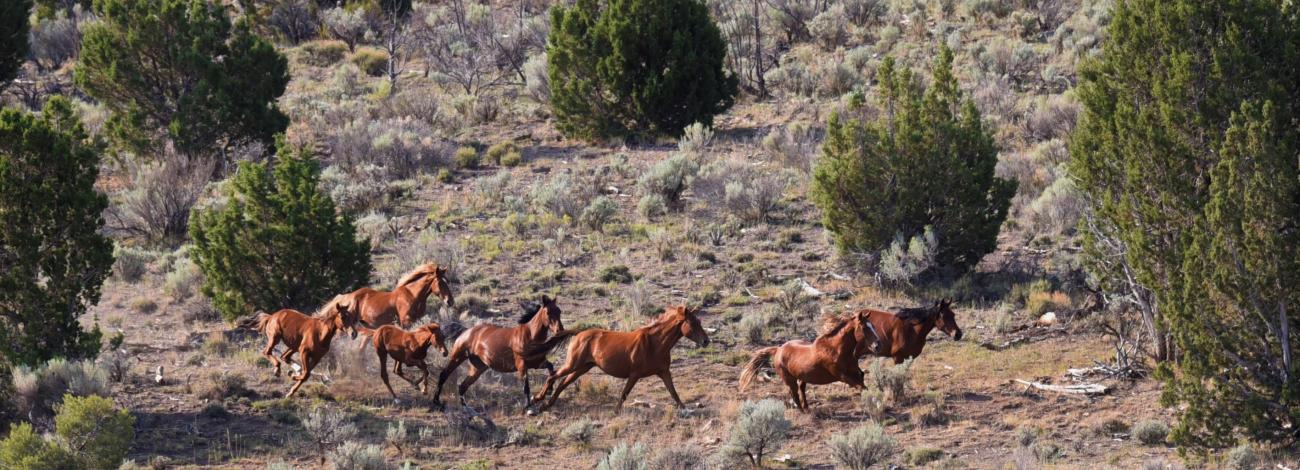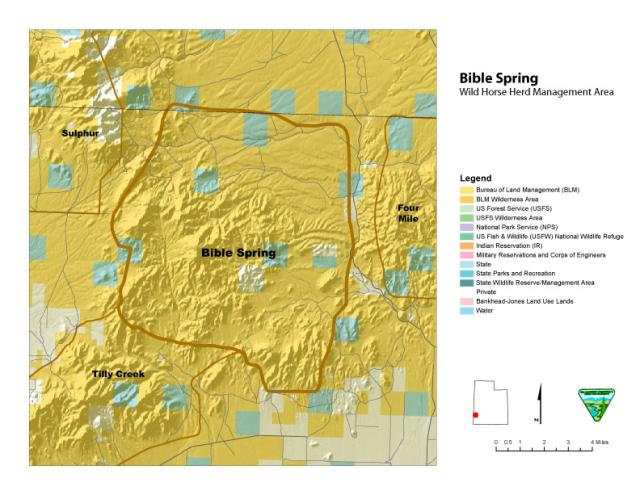
Bible Spring Herd Management Area (HMA)
The herd’s lineage is based in ranching and mining stock, and their size and colors vary. Most of the wild horses are bays, sorrels and brown, but there are pintos, palominos, buckskins, roans and grullas.
Location
The herd is located in Iron and Beaver counties; approximately 45 miles West of Cedar City, Utah, and accessible via the Lund Highway.
Size
The Herd Management Area contains 56,588 acres of BLM lands and 5,274 acres of Federal, State, and privately-owned land for a total of 61,862 acres.
Topography/Vegetation
The Herd Management Area supports multiple vegetation types including grasslands, sagebrush, sagebrush/grasslands, Pinyon-juniper, mountain fir, and mountain fir/mountain shrub. The Pinyon-juniper woodland type dominates the Herd Management Area and is very dense with minimal understory forage. Open areas outside the Pinyon-juniper canopy are dominated by big sagebrush with Indian ricegrass, wheatgrass, bluegrass, and squirreltail grass as the primary forage species. Low elevations are around 5,500 feet, with higher elevations around 8,500 feet. Average annual precipitation in the Herd Management Area is 12.5 inches a year, depending on elevation. Available water within the Herd Management Area is the limiting factor regarding the wild horse populations. Water is limited to isolated springs and built structures that supply water to permitted livestock, wildlife and wild horses. The Herd Management Area is prone to drought every few years, which impacts the rangeland health within the area.
Wildlife
Big game species that occur in the Herd Management Area are mule deer, elk, and pronghorn antelope. All three species are year-long residents. During spring, summer and early fall, deer feed primarily on a variety of forbs and grasses with light use on big sagebrush, black sagebrush and bitterbrush. In fall and winter, deer shift their diet to shrubs including big sagebrush, black sagebrush, bitterbrush, Gambel oak and curlleaf mountain mahogany. Antelope’s primary forage plants include a variety of grasses and forbs in late spring, summer and early fall, and big sagebrush, black sagebrush, winterfat and bud sage in late fall, winter and early spring. Elk rely primarily on grasses year-long for forage, but will use some forbs in spring and summer and shrubs in winter.
A variety of migratory birds inhabit the Herd Management Area during the spring, summer and fall months. Sensitive Species that have been identified as occurring in the area are Black rosy finch, Black-throated gray warbler, Brewer’s sparrow, Broad-tailed hummingbird, Gray vireo, Lewis’s woodpecker, loggerhead shrike, prairie falcon, sage sparrow and Virginia’s warbler. Additionally, golden eagles may occur on the wild horse Herd Management Area year-round.
Appropriate Management Level
The appropriate management level is 30 to 60 animals. This area is no longer managed as a standalone Herd Management Area but is part of the Bible Spring Complex (Bible Spring, Four Mile and Tilly Creek Herd Management Areas).
In April of 2005, the appropriate management levels on the Bible Spring, Four Mile, and Tilly Creek herd management areas were adjusted to maintain an ecological balance based on changes in vegetation conditions and land tenure. At that time, it was determined that the Bible Spring, Four Mile and Tilly Creek herd management areas would be managed as a complex and possibly combined into one herd management area in future land use plans. Blawn Wash Herd Management Area would no longer be managed for wild horses due to a Congressionally mandated land exchange in 2001 between the BLM and the State of Utah School and Institutional Trust Lands Administration (SITLA), which placed the most critical wild horse habitat of the Blawn Wash Herd Management Area lands into SITLA ownership and administration.
Viewing Opportunities
Travel north from Modena, Utah, through Modena Canyon to the Hamlin Valley “T.” Head east along the Negro Liza Canyon Road (4x4) toward Beryl. Exploring roads that go north into Wilson Canyon area. Or travel west from Lund, Utah, along the Pine Valley Road approximately 10.7 miles to the Bible Spring road. Follow the Bible Spring road to Bible Spring. Wild Horses can be anywhere along these routes. Thick pinyon-juniper tree cover can make viewing opportunities more difficult.
Special Travel Conditions
Roads are impassable in wet/snowy weather. A 4x4 vehicle is required even in good weather conditions due to seasonally changing road conditions. Be prepared with plenty of water, food and fuel for the day. Let people know where you are going.

